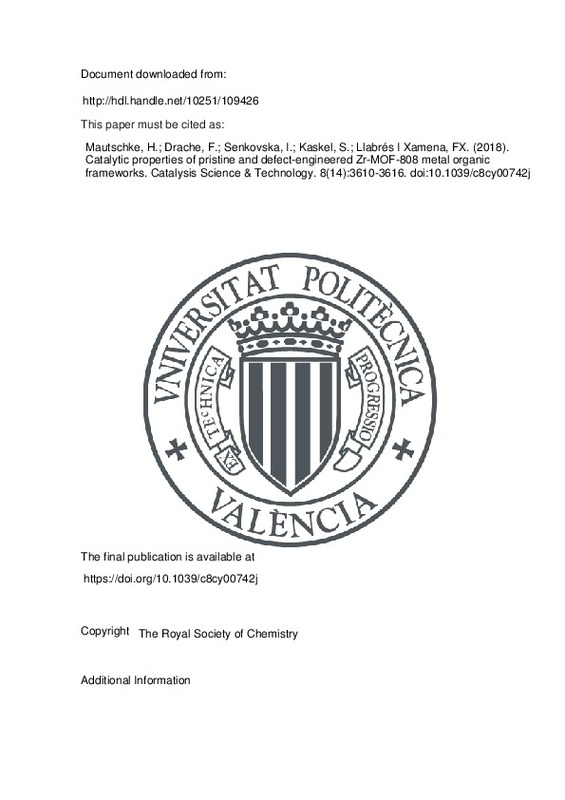JavaScript is disabled for your browser. Some features of this site may not work without it.
Buscar en RiuNet
Listar
Mi cuenta
Estadísticas
Ayuda RiuNet
Admin. UPV
Catalytic properties of pristine and defect-engineered Zr-MOF-808 metal organic frameworks
Mostrar el registro sencillo del ítem
Ficheros en el ítem
| dc.contributor.author | Mautschke, Hans-Hilmar
|
es_ES |
| dc.contributor.author | Drache, F.
|
es_ES |
| dc.contributor.author | Senkovska, I.
|
es_ES |
| dc.contributor.author | Kaskel, S.
|
es_ES |
| dc.contributor.author | Llabrés i Xamena, Francesc Xavier
|
es_ES |
| dc.date.accessioned | 2018-10-05T04:31:16Z | |
| dc.date.available | 2018-10-05T04:31:16Z | |
| dc.date.issued | 2018 | es_ES |
| dc.identifier.issn | 2044-4753 | es_ES |
| dc.identifier.uri | http://hdl.handle.net/10251/109426 | |
| dc.description.abstract | [EN] Various defect-engineered Zr-trimesate MOF-808 compounds (DE-MOF-808) have been prepared by mixing the tricarboxylate ligands with dicarboxylate ligands; viz. isophthalate, pyridine-3,5-dicarboxylate, 5-hydroxy-isophthalate, or 5-amino-isophthalate. The resulting mixed-ligand compounds, MOF-808-X (X = IP, Pydc, OH or NH2) were all found to be highly crystalline and isostructural to the unmodified MOF-808. Pristine MOF-808 showed better catalytic performance than a UiO-66 reference compound for the Meerwein-Ponndorf-Verley (MPV) reduction of carbonyl compounds. This was attributed to a higher availability of coordinatively unsaturated Zr4+ sites (cus) in MOF-808 upon removal of formate ions. Meanwhile, cus in UiO-66 are only located at defect sites and are thus much less abundant. Further improvement of the catalytic activity of defect-engineered MOF-808-IP and MOF-808-Pydc was observed, which may be related with the occurrence of less crowded Zr4+ sites in DE-MOF-808. The wider pore structure of MOF-808 with respect to UiO-66 compounds translates into a sharp improvement of the activity for the MPV reduction of bulky substrates, as shown for estrone reduction to estradiol. Interestingly, MOF-808 produces a notable diastereoselectivity towards the elusive 17--hydroxy estradiol. | es_ES |
| dc.description.sponsorship | This project has received funding from the European Union's Horizon 2020 research and innovation programme under the Marie Sklodowska-Curie grant agreement No. 641887 (project acronym: DEFNET). Financial support from the Spanish Ministry of Economy and Competitiveness (program Severo Ochoa SEV20120267), the Spanish Ministry of Science and Innovation (project MAT2014-52085-C2-1-P), and the German Research Foundation (project KA 1698/19-1) is also gratefully acknowledged. The Microscopy Service of the Universitat Politecnica de Valencia are gratefully acknowledged for the SEM images. | en_EN |
| dc.language | Inglés | es_ES |
| dc.publisher | The Royal Society of Chemistry | es_ES |
| dc.relation.ispartof | Catalysis Science & Technology | es_ES |
| dc.rights | Reserva de todos los derechos | es_ES |
| dc.title | Catalytic properties of pristine and defect-engineered Zr-MOF-808 metal organic frameworks | es_ES |
| dc.type | Artículo | es_ES |
| dc.identifier.doi | 10.1039/c8cy00742j | es_ES |
| dc.relation.projectID | info:eu-repo/grantAgreement/MINECO//MAT2014-52085-C2-1-P/ES/NUEVOS MATERIALES CON DIFERENTES CENTROS ACTIVOS INCORPORADOS EN POSICIONES ESPECIFICAS DE LA RED Y SU APLICACION PARA PROCESOS CATALITICOS MULTI-ETAPA Y NANOTECNOLOGICOS/ | es_ES |
| dc.relation.projectID | info:eu-repo/grantAgreement/EC/H2020/641887/EU/DEFect NETwork materials science and engineering/ | es_ES |
| dc.relation.projectID | info:eu-repo/grantAgreement/MINECO//SEV-2012-0267/ | es_ES |
| dc.relation.projectID | info:eu-repo/grantAgreement/DFG//KA 1698%2F19-1/ | |
| dc.rights.accessRights | Abierto | es_ES |
| dc.date.embargoEndDate | 2019-07-21 | es_ES |
| dc.contributor.affiliation | Universitat Politècnica de València. Instituto Universitario Mixto de Tecnología Química - Institut Universitari Mixt de Tecnologia Química | es_ES |
| dc.description.bibliographicCitation | Mautschke, H.; Drache, F.; Senkovska, I.; Kaskel, S.; Llabrés I Xamena, FX. (2018). Catalytic properties of pristine and defect-engineered Zr-MOF-808 metal organic frameworks. Catalysis Science & Technology. 8(14):3610-3616. https://doi.org/10.1039/c8cy00742j | es_ES |
| dc.description.accrualMethod | S | es_ES |
| dc.relation.publisherversion | https://doi.org/10.1039/c8cy00742j | es_ES |
| dc.description.upvformatpinicio | 3610 | es_ES |
| dc.description.upvformatpfin | 3616 | es_ES |
| dc.type.version | info:eu-repo/semantics/publishedVersion | es_ES |
| dc.description.volume | 8 | es_ES |
| dc.description.issue | 14 | es_ES |
| dc.relation.pasarela | S\367924 | es_ES |
| dc.contributor.funder | Ministerio de Economía y Competitividad | es_ES |
| dc.contributor.funder | European Commission | es_ES |
| dc.contributor.funder | Deutsche Forschungsgemeinschaft |







![[Cerrado]](/themes/UPV/images/candado.png)

